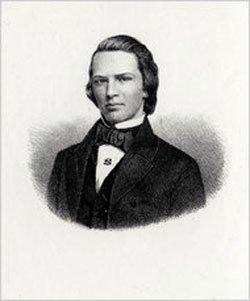Affirmative Portraiture
Affirmative Action, Edward Bouchet, Racial Favoritism, Racial Politics, Randall Lee Gibson, Saybrook College, Yale

Asher Liftin ’21 admiring the new portrait of Edward Bouchet, Y’ 1874.
If you were born white, in order to have your portrait painted and hung in one of Yale’s residential colleges, you would need to have been an exceptionally important and renowned scholar who had made major contributions to his field.
If you were African-American, the standard is just a little easier. All you have to have done is be supposedly the first representative of your identity group to attend Yale.
Yale News piously propagandizes:
[A] committee established by Head of [Saybrook] College Thomas Near … recommended commissioning Bouchet’s portrait. Near, the students, and some of their fellow residents in Saybrook College had been having conversations about how to more fully represent Yale’s history in the dining hall.
“In the very Gothic space, we have a collection of portraits that were loaned from the Yale University Art Gallery in 1933 when the college opened,†said Near. “We also have a set of what I call ‘family portraits’ — those who served Saybrook as the heads and deans of the college and their spouses. All of the people pictured are white, which is not representative of Yale’s true history.â€
The addition of the Bouchet portrait is just the start of bringing “the narratives of people who have for too long been ignored, overlooked, and marginalized, to come to the surface†to campus spaces, Near said at the unveiling. “In North America there is no history that is not Black history, and this is absolutely true for the history of Yale.â€
Edward Bouchet is very probably the only Yale alumnus with merely a pedestrian career as a high school teacher to be so honored.
Unfortunately, on top of everything else, the powers that be at Yale, and at Saybrook College, are just plain wrong. Edward Bouchet, Class of 1874, was not the first student of color to graduate from Yale. That distinction belongs to Confederate Brigadier General, later Congressman and Senator from Louisiana, Randall Lee Gibson, valedictorian of the Yale Class of 1853.





